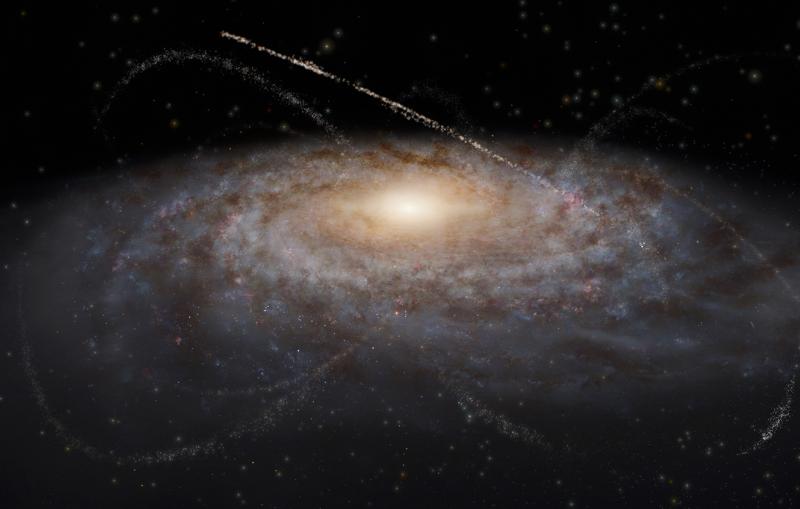How exoplanets could aid the search for dark matter
Rebecca Leane and colleagues showed dark matter could heat planets in our galaxy to incredible temperatures. Here, she explains how that works and how it could pave the way for sensitive new searches for the mysterious substance.

The hunt for dark matter is a tough one. Although it makes up around 85% of the matter in the universe, observations to date point to it being made up of elementary particles that likely interact only very weakly with ordinary matter. The only way we know that dark matter exists, in fact, is through puzzling observations that reveal dark matter’s gravitational influence on the way matter clumps together, on the way galaxies spin and so forth.
So far, physicists have focused mainly on two broad ways to learn more: In ground-based experiments, they can try to capture the rare occasions on which dark matter interacts with ordinary matter, or, drawing on detailed observations of the sky, they can place limits on what kind of particles dark matter comprises. A third, somewhat more unusual approach is to search the heavens for signs that dark matter particles might be annihilating each other, creating gamma rays or other ordinary matter particles that then make their way to Earth.
And then there is Rebecca Leane, a physicist at the Department of Energy’s SLAC National Accelerator Laboratory. Leane, a postdoctoral fellow who will soon join SLAC's fundamental physics group as a staff scientist, and Ohio State University physicist Juri Smirnov proposed in a recent paper that exoplanets – planets outside our solar system – could aid the search. According to their calculations, certain kinds of dark matter could drastically increase the temperatures of exoplanets near the center of our galaxy.
Here, Leane talks about how dark matter could heat up exoplanets and how experiments already in the works could provide some of the best evidence to date on the existence and nature of dark matter.
What happens when exoplanets interact with dark matter?
We know we have exoplanets that are scattered throughout the galaxy, and we think there is a dark matter halo that extends throughout our galaxy. As exoplanets pass through the dark matter halo, the dark matter can scatter off them. If the dark matter particles scatter, they can lose energy and become gravitationally captured by the exoplanets.
Over time, more and more dark matter particles can become captured, and once you start getting a lot of dark matter particles inside the exoplanet, they can start annihilating each other, if it’s the type of dark matter that annihilates. Then the energy from this annihilation can be absorbed by the planet, and if the energy is absorbed, the temperature increases.
Where did the idea to look for exoplanet heating come from?
Particularly recently, people had been speaking about how dark matter could heat up something called neutron stars, which are effectively just very dense balls predominantly made up of neutrons. It had been already pointed out that if you found a sufficiently close-by neutron star, you could use upcoming infrared telescopes, particularly the James Webb Space Telescope, to measure its temperature. So, people had already considered looking for dark matter heating in one object with this telescope.
What we realized was that an exoplanet can be a thousand times bigger than a neutron star, and because they’re so big, you can see them from much farther away. And because you have lots of exoplanets between here and the center of the galaxy, we can potentially trace out the dark matter density in the galaxy.
The giveaway would be you just see way too many planets that are way too hot, and their temperatures are correlated with dark matter density – they’re hotter in the center of the galaxy where there’s more dark matter, and their temperatures drop off farther out.
What’s “way too hot”?
It depends on the type of planet, but we could get temperatures in the ballpark of 1,000 kelvins [roughly 700°C or 1,300°F], compared to a prediction of only 200 kelvins [-73°C or -100°F] or so for planets without dark matter.
Do the details of a planet’s geophysics matter?
It does matter. For example, if you think about rocky planets like the Earth or Venus or Mars, they’re not ideal because they’re generally pretty small. Instead, the bigger the planet, the better a target it is. Bigger planets generally have more dark matter passing through them, so generally they get hotter, but you also want planets that are not naturally too hot themselves. For example, we think dark matter could be captured in the sun, but the sun’s already just so hot you’d never see any dark matter heat.
The optimal sorts of candidates are jupiters or brown dwarfs. Jupiters are planets just like our Jupiter, and these are supposed to be pretty common. This also extends to super jupiters, which are like Jupiter but 10 times bigger. Brown dwarfs can be quite heavy, and if they’re quite old, they’re usually the size of Jupiter, which means they’re very dense, so they’re very good at capturing dark matter particles.
What are the prospects for actually conducting this kind of search?
The great thing is we can piggyback off other searches. Part of the James Webb Space Telescope mission is to measure the temperature of exoplanets, so this is already something people are going to do. And then there are lots of searches where people want to look at the center of the galaxy for other sorts of reasons.
Another great thing about the search we’re proposing is that there’s supposed to be a lot of exoplanets out there, something like 300 billion in the galaxy. This means that there is just so much discovery potential for this search. We’re not going to find all of these exoplanets right away, and you have to find the right ones, but the Roman Telescope is expected to find at least a few hundred of the type of candidates that we want in the next few years. So that seems very promising.
The research was funded in part by the DOE Office of Science, the NASA Fermi Guest Investigator Program, and the Alexander von Humboldt Foundation.
Citation: Leane and Smirnov, Physical Review Letters, 22 April 2021 (10.1103/PhysRevLett.126.161101)
For questions or comments, contact the SLAC Office of Communications at communications@slac.stanford.edu.
SLAC is a vibrant multiprogram laboratory that explores how the universe works at the biggest, smallest and fastest scales and invents powerful tools used by scientists around the globe. With research spanning particle physics, astrophysics and cosmology, materials, chemistry, bio- and energy sciences and scientific computing, we help solve real-world problems and advance the interests of the nation.
SLAC is operated by Stanford University for the U.S. Department of Energy’s Office of Science. The Office of Science is the single largest supporter of basic research in the physical sciences in the United States and is working to address some of the most pressing challenges of our time.





